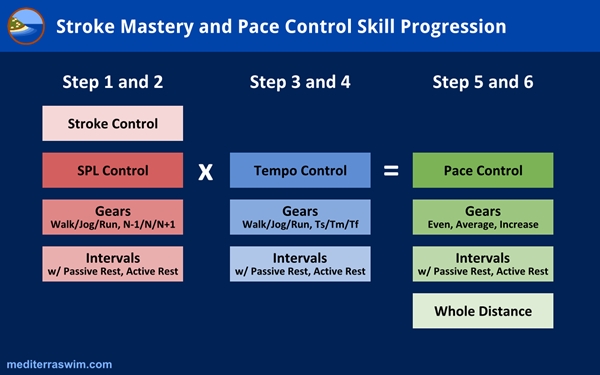Here is a question for you…
If you faithfully follow the TI freestyle drill sequence, use focal points well, mix it in with your whole stroke swimming, and take your time to master every piece – will you eventually turn into a faster swimmer?
Or, in terms of our organized sequence of Level 1 and Level 2 skills, if you work a long time at Level 1 until you feel like you can perform every body position and stroke control detail well, will you automatically become a faster swimmer? (I suspect this disappointed swimmer practiced a lot at Level 1 and yet expected a Level 2 result.)
Short answer: No. You won’t necessarily get faster. Because Step 1 is about learning how to form and control the stroke. In this step you are just discovering how to align the body and adjust the stroke using all the various control points. Step 2 and 3 are showing you what to do with that stroke control to set up the conditions for increased speed – basic stroke length and tempo skills. Steps 4, 5 and 6 are where you learn to produce speed upon that foundation.
Learning how to pull on levers, push buttons and turn dials on the dashboard of an race car will not qualify you to race that car, no matter how many months you sit there and tinker with the dashboard. You’ve got to take that car onto the track and learn how to make the vehicle do things (faster!) with those levers, buttons and dials. You need to drive the car on a real track, under real conditions.

This chart shows how we break down the skill progression. The swimmer only get to the results of Step 5 and 6 by first going through Steps 1 to 4.
So too, with your own stroke in Step 1, you’ve been learning how to notice and adjust little details in your body position and stroke control. This is just the beginning. You are going to need to take that skill and put it to practice on gradually increasing challenges using the variables of Stroke Length and Tempo and Distance to create that increase in challenge. By doing this, your fitness (ability to generate power) will develop in parallel with your technique (ability to apply power with precision, where it is needed).
Those two – fitness and technique – are inseparable in training because all movement patterns are training the neuro-muscular system –teaching the body where and how to deliver power while you generate it. So, if you are going to do any movement to build power for swimming, you need to train the precision of movement to go with it at the same time. That is a core principle in TI training.

